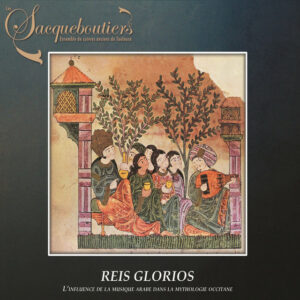Program: #22-20 Air Date: May 16, 2022
To listen to this show, you must first LOG IN. If you have already logged in, but you are still seeing this message, please SUBSCRIBE or UPGRADE your subscriber level today.
While we have now heard many recordings by this Toulouse-based instrumental ensemble, there is one rare treasure we have held back; it traces the influence of Arabic music on the Troubadour culture.
NOTE: All of the music on this program is from the ensemble Les Sacqueboutiers de Toulouse.
Since their founding in 1976, Les Sacqueboutiers have dedicated themselves to rediscovering the practice of ancient brass and the vast repertoire of the Renaissance , the golden age of their instruments. They have established themselves as one of the most imaginative early music ensembles. The search for musical excellence remains the driving force of their work. Selected as Ensemble of the Year at the Victoires de la Musique Classique 2008 , they collaborated with the most prestigious ensembles to perform repertoires ranging from the Renaissance to Mozart: Hesperion XXI , The Arts Florissants , The Royal Chapel , The Great Stable and the Chambre du Roy, the vocal ensemble Clément Janequin.
The Sacqueboutiers are not limited to the repertoire of the Renaissance.Their creativity leads them to design shows that combine ancient music with other artistic universes: contemporary music, dance, the world of puppetry, jazz, literature, ethnomusicology.
For more information:
https://www.les-sacqueboutiers.com/

Les Sacqueboutiers de Toulouse. Reis Glorios L’Influence de La Musique Arabe Dans la Mythologie Occitane. Flora Records Flora 3916 (2015).
Jean-Pierre Canihac; cornetto, Philippe Canguilhem; chalemie, bombarde, medieval flute a bec, Daniel Lassalle; sacqueboute, Lucile Tesier; bombarde, medieval flute a bec, Jodel Grasset-Saruwatari; medieval lute, rebec, oud, arch lute, Florent Tisseyre, tambourine, daf, panderata, derbuouka, buche, cloches. Guest Musicians: Pierre Hammon; medieval flute a bec, double flute, bansouri, cornemuse, Driss El maloumi; oud, chant, Pierre-Yes Binard; vocal, Renat Jurie; vocal.
Arab civilization has left traces in Occitania much more numerous in the late Middle Ages (fourteenth and fifteenth centuries) through trade and crusades than it dit during the High Middle Ages (from the eighth to tenth centuries). Between land of Islam and land of Oc, there is no unbridgeable gap. At successive times its submission to the Carolingian Franks and afterwards to the French of Simon de Montfort, the deep South has naturally turned to Andalousia, whose civilization shines il all its brilliance. The musical program Glorios Reis, presented by The Sacqueboutiers with the assistance of master oud, Driss el Maloumi, highlights the close ties that have been forged between the art of the troubadours and Arab civilizations of the late Middle Ages. Traditional pieces of oriental origin alternate with music from great collections of Occitans of that time, as the manuscript of Apt or the famous Vermeil book of Montserrat and signed scores of the great troubadours of the rich period: Bertran de Born, Girau of Bornèlh, Bernard Ventadorn.
From Historic Brass: The most recent CD, Reis Glorios, is a collection of medieval dances, and vocal works that emphasize the Muslim cultural influence on Occatania. Occitania was a historical region encompassing Southern France, Spain and parts of Italy. Never formally a country Occitania did develop unique cultural and linguistic traditions. Mostly anonymous pieces, these works are brought to light by Les Sacqueboutiers’ imaginative and colorful instrumentation and impressive virtuosity. The title piece, Reis Giorios is a work by the 12th century troubadour, Girau de Bornelh and is mournful and expressively performed by Pierre-Yves Binard and beautifully supported by the ensemble. Of special note is O Felix Templum Jubila by Johannes Ciconia, the one major composer represented on this recording. This four-part motet is given an instrumental rendition by the wind band and their beautiful ensemble sound is showcased. Canihac’s full cornetto tone is clear and vibrant throughout. The bulk of the repertoire on this fine recording are anonymous vocal and dance pieces given a splendid reading by Les Sacqueboutiers. Their interpretation makes a strong case for Muslim musical influence. In any event, the musical outcome is wonderful.